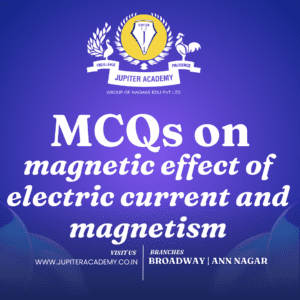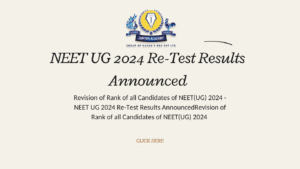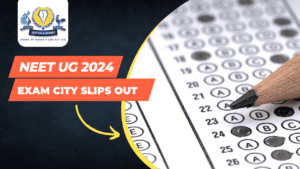NEET UG 2024 Re-Test result NTA Had Conducted the Re-test...
Read MoreMCQs on Magnetic effect of electric current & Magnetism

Magnets can be of two types as Natural magnets and Artificial Magnets. Magnetite and loadstone are examples of natural magnets while a bar magnet, electromagnet and a horseshoe magnet are examples of artificial magnets.
Thank you for reading this post, don't forget to subscribe!Following are the properties of magnets:
- Like magnetic poles repel each other while unlike magnetic poles attract each other.
- A freely suspended magnet aligns itself into a north-south direction
- Magnetic poles exist in pairs
When a magnetic dipole is placed in a uniform magnetic field then a torque acts on it which is given by the formula:
τ = M B sin θ
NEET – JEE (National Eligibility cum Entrance Test) style multiple-choice questions on the topic of magnetic effect of electric current and magnetism, along with their answers:
1. Which of the following statements is true about magnetic field lines?
a) They originate from the north pole and terminate at the south pole of a magnet.
b) They originate from the south pole and terminate at the north pole of a magnet.
c) They always form closed loops.
d) They exist only outside the magnet.
Answer: c) They always form closed loops.
2. According to Ampere’s circuital law, the line integral of the magnetic field along a closed path is equal to:
a) The product of magnetic field and the length of the closed path.
b) The product of magnetic field and the area enclosed by the closed path.
c) The product of magnetic field and the displacement along the closed path.
d) Zero.
Answer: b) The product of magnetic field and the area enclosed by the closed path.
3. A wire carrying an electric current produces a magnetic field. The direction of the magnetic field around the wire can be determined using:
a) Ampere’s circuital law.
b) Lenz’s law.
c) Right-hand thumb rule.
d) Ohm’s law.
Answer: c) Right-hand thumb rule.
4. Which of the following materials can be easily magnetized?
a) Copper
b) Aluminum
c) Iron
d) Silver
Answer: c) Iron
5. The SI unit of magnetic field intensity is:
a) Tesla
b) Weber
c) Ampere
d) Coulomb
Answer: a) Tesla
6. When a current-carrying wire is placed in a magnetic field, it experiences a force. This force is maximum when the angle between the wire and the magnetic field is:
a) 0 degrees
b) 45 degrees
c) 90 degrees
d) 180 degrees
Answer: c) 90 degrees
7. When a bar magnet is suspended freely, it comes to rest in which direction?
a) East-West
b) North-South
c) Up-Down
d) Random direction
Answer: b) North-South
8. The phenomenon of electromagnetic induction is based on:
a) Faraday’s law
b) Lenz’s law
c) Ohm’s law
d) Ampere’s law
Answer: a) Faraday’s law
9. The force experienced by a charged particle moving in a magnetic field depends on:
a) Charge of the particle
b) Velocity of the particle
c) Strength of the magnetic field
d) All of the above
Answer: d) All of the above
10. In a transformer, the number of turns in the primary coil is 200 and in the secondary coil is 800. If the input voltage is 220 V, the output voltage will be:
a) 55 V
b) 88 V
c) 440 V
d) 880 V
Answer: d) 880 V
neet physics mcqs
11..A current-carrying conductor is placed in a magnetic field. The direction of the force on the conductor is:
(A) Parallel to the current. (B) Perpendicular to the current and the magnetic field. (C) Perpendicular to the current but parallel to the magnetic field. (D) None of the above.
Answer: (B)
The force on a current-carrying conductor in a magnetic field is perpendicular to both the current and the magnetic field. This is known as the Lorentz force.
12.A circular loop of wire is placed in a uniform magnetic field. The current in the loop is increased. What will happen to the magnetic field inside the loop?
(A) The magnetic field will increase. (B) The magnetic field will decrease. (C) The magnetic field will remain the same. (D) The direction of the magnetic field will change.
Answer: (A)
When the current in a circular loop of wire is increased, the magnetic field inside the loop also increases. This is because the current creates a magnetic field around the wire, and the stronger the current, the stronger the magnetic field.
13.A long, straight wire carries a current. A compass is placed near the wire. The compass needle will:
(A) Point in the same direction as the current. (B) Point in the opposite direction of the current. (C) Point perpendicular to the current. (D) Not move at all.
Answer: (C)
The compass needle will point perpendicular to the current. This is because the current creates a magnetic field around the wire, and the compass needle will align itself with the magnetic field.
14.A solenoid is a coil of wire that has a current flowing through it. The magnetic field inside the solenoid is:
(A) Zero. (B) Weak. (C) Strong. (D) Very strong.
Answer: (C)
The magnetic field inside a solenoid is very strong. This is because the magnetic fields of all the individual turns of wire add together to create a strong magnetic field along the axis of the solenoid.
15.A moving charge experiences a force when it is placed in a magnetic field. This force is called the:
(A) Lorentz force. (B) Coulomb force. (C) Magnetic force. (D) Electric force.
Answer: (A)
The Lorentz force is the force that a moving charge experiences when it is placed in a magnetic field. It is named after Hendrik Lorentz, who first described it in 1895.
I hope these questions help you in your preparation for NEET - JEE!
JEE Advanced 2024 registration window opens at jeeadv.ac.in. Here is how to apply
JEE Advanced 2024 registration window opens The Indian Institute of...
Read MoreLast chance for Photo correction in NEET 2024 Forms
Last Chance for Photo Correction in NEET 2024 Forms! Don’t...
Read MoreNEET UG 2024 exam city slips out now
Registered candidates can download their city slips from the official...
Read MoreMCQs on Magnetic effect of electric current & Magnetism MCQs on Magnetic effect of electric current & Magnetism MCQs on Magnetic effect of electric current & Magnetism MCQs on Magnetic effect of electric current & Magnetism MCQs on Magnetic effect of electric current & Magnetism MCQs on Magnetic effect of electric current & Magnetism MCQs on Magnetic effect of electric current & Magnetism MCQs on Magnetic effect of electric current & Magnetism MCQs on Magnetic effect of electric current & Magnetism MCQs on Magnetic effect of electric current & Magnetism
MCQs on Magnetic effect of electric current and Magnetism MCQs on Magnetic effect of electric current and Magnetism MCQs on Magnetic effect of electric current and Magnetism
neet physics mcqs neet physics mcqs neet physics mcqs neet physics mcqs neet physics mcqs neet physics mcqs neet physics mcqs





